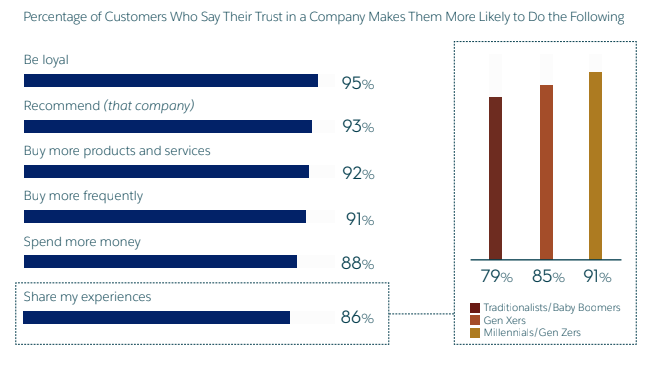No ifs, ands, or buts about it, customers need to trust your business if they are going to buy from you. Unfortunately, most consumers have had a negative interaction with brands in the past, so they approach most companies with a level of skepticism.
This problem is even greater when it comes to online shopping, as it lacks that physical connection where customers can talk face-to-face with a salesperson or touch and try out the product on their own.
But trust isn’t just a necessary ingredient to a conversion. According to Salesforce’s report:
- 95% of customers that have a high sense of trust in a business are more likely to be repeat customers.
- 93% are more likely to recommend the company to a friend.
- 92% are more likely to spend more per purchase.

Benefits like these make it quite apparent as to why you should want to cultivate trust with your new, existing, and potential customers. Without a doubt, the best way that companies specifically build trust is through on-site content. This is how most consumers will use to learn about the business and form their opinions.
Here are three easy ways that you can use website content to nurture confidence with customers.
Talk About the Measures You Take to Keep Them Secure
Salesforce’s previously mentioned report also found that data safety and security was one of the leading reasons why consumers distrusted an online business. Nearly 60% of customers believe that sharing their personal information online puts them at risk, and 54% did not think that companies are doing enough to keep their data secure.
Obviously, the checkout process presents the biggest number of risks to a consumer who may be wary of their data protection.
While you don’t need to go into great detail, be sure that you blatantly guarantee their financial protection by using an SSL certified checkout process, encryption services, or firewalls. You may want to write a brief disclaimer explaining what each of these systems does and how they are intended to keep that customer’s sensitive data protected from hackers.
This is incredibly important for businesses of all sizes to do. Most importantly, e-commerce stores that sell more expensive items really need to make their security measures incredibly apparent to buyers.
For example, if you sell jewelry online and handle fairly large transactions, you will want to include additional authentication steps like ReCaptcha to ensure that each purchase is protected.

You may also want to require customers to create an account with a double authentication log-in process for extra security. Many customers are fearful of data breaches and the security of their private information. Be sure to calm these fears by sharing the steps you have taken to keep them safe. Transparency is the key here.
If you track their behavior through cookies, share why and how you use this information to benefit them with things like personalized product recommendations or customized experiences. Be sure that you also are perfectly clear on who has access to this information. Some businesses do sell consumer data to other advertisers, so you need to be 100% honest with your customers if this information is shared.
Incorporate User-Generated Content (UGC)
One of the most effective ways to combat consumer distrust is by using other customers to sway their opinion. Customer reviews are perceived as extremely trustworthy content – 91% of consumers trust them just as much as a personal recommendation. Moreover, 86% actively seek them out when shopping online.
Make sure that you are incorporating this feedback throughout your website – not just on third-party review sites on specific product pages. Displaying clips of customer testimonials on your home page is a great way to build trust immediately when a new customer visits your site.
It is also a good idea to incorporate social proof and visual UGC on your website as well. By showing customers that other people use your products and genuinely love them enough to share them on their social media feeds, it creates a brand community that new customers can identify with.
Take the online mattress company Casper Mattress’ homepage as an example. Much of their content is based around what other people have to say about their product. Clips from customer testimonials are posted throughout their site, and viewers can also browse through hundreds of UGC pictures that customers have shared on their social media pages.
This immediately proves to new visitors that other customers love this product and it gives them a better idea of what to expect.
Offer Great Non-Promotional Advice
The things that your brand has to say about itself has a strong influence on the perception that customers will have towards your business. If the majority of your content is promotional or just talking about how great your product is, it is not really providing much substance. Furthermore, since customers are already skeptical of branded content, they won’t believe much of what you say anyways.
Instead, shift the focus of your content so that it makes a bigger impact. One way to do so is by using a problem-solving approach by offering advice or helpful guides to your customers. If your business sells cooking supplies, share recipes or give advice on how to keep these items clean and in tip-top shape. If your focus is more in the B2B sector, offer advice on ways to improve or explain trends and concepts that are related to your industry. By doing so, you can set your company apart from the rest and showcase your expertise.
Although you wouldn’t necessarily expect it, the flour brand King Arthur provides an excellent example of using informational and helpful content to promote their brand. Their website is chock full of recipes and guides, and they even offer online cooking classes. This helps to establish credibility and builds consumer trust in their brand name.

Conclusion
Remember, trust with your customers is not something that is built right away – it must be earned. Typically, this will take some time. This is why it is best to use multiple approaches in order to influence consumer opinion. When it comes to their biggest fears, be sure that you are doing all you can to keep them secure and be totally transparent with your policies.
Make the most of your customer reviews by having them highly visible throughout your website. And finally, use your website content to establish your brand as an expert in the field by providing valuable information they can’t get anywhere else.


